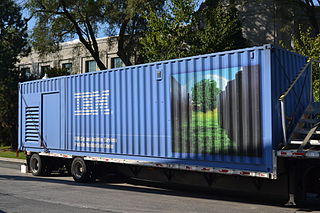
Sun Microsystems, Inc. was an American technology company that sold computers, computer components, software, and information technology services and created the Java programming language, the Solaris operating system, ZFS, the Network File System (NFS), and SPARC microprocessors. Sun contributed significantly to the evolution of several key computing technologies, among them Unix, RISC processors, thin client computing, and virtualized computing. Notable Sun acquisitions include Cray Business Systems Division, Storagetek, and Innotek GmbH, creators of VirtualBox. Sun was founded on February 24, 1982. At its height, the Sun headquarters were in Santa Clara, California, on the former west campus of the Agnews Developmental Center.

Containerization is a system of intermodal freight transport using intermodal containers. Containerization, also referred as container stuffing or container loading, is the process of unitization of cargoes in exports. Containerization is the predominant form of unitization of export cargoes, as opposed to other systems such as the barge system or palletization. The containers have standardized dimensions. They can be loaded and unloaded, stacked, transported efficiently over long distances, and transferred from one mode of transport to another—container ships, rail transport flatcars, and semi-trailer trucks—without being opened. The handling system is mechanized so that all handling is done with cranes and special forklift trucks. All containers are numbered and tracked using computerized systems.

Corrugated fiberboard or corrugated cardboard is a type of packaging material consisting of a fluted corrugated sheet and one or two flat linerboards. It is made on "flute lamination machines" or "corrugators" and is used for making corrugated boxes. The corrugated medium sheet and the linerboard(s) are made of kraft containerboard, a paperboard material usually over 0.25 millimetres (0.01 in) thick.

An intermodal container, often called a shipping container or ISO Container, is a large standardized container designed and built for intermodal freight transport, meaning these containers can be used across different modes of transport – such as from ships to trains to trucks – without unloading and reloading their cargo. Intermodal containers are primarily used to store and transport materials and products efficiently and securely in the global containerized intermodal freight transport system, but smaller numbers are in regional use as well. These containers are known under a number of names. Based on size alone, up to 95% of intermodal containers comply with ISO standards, and can officially be called ISO containers. Many other names are simply: container, cargo or freight container, shipping, sea or ocean container, container van or sea van, sea can or C can, or MILVAN, SEAVAN, or RO/RO. The also used term CONEX (Box) is a technically incorrect carry-over usage of the name of an important predecessor of the international ISO containers, namely the much smaller prior steel CONEX boxes used by the U.S. Army.

William Daniel Hillis is an American inventor, entrepreneur, and computer scientist, who pioneered parallel computers and their use in artificial intelligence. He founded Thinking Machines Corporation, a parallel supercomputer manufacturer, and subsequently was Vice President of Research and Disney Fellow at Walt Disney Imagineering.

A data center or data centre is a building, a dedicated space within a building, or a group of buildings used to house computer systems and associated components, such as telecommunications and storage systems.
NetApp, Inc. is an intelligent data infrastructure company that provides unified data storage, integrated data services, and cloud operations (CloudOps) solutions to enterprise customers. The company is based in San Jose, California. It has ranked in the Fortune 500 from 2012 to 2021. Founded in 1992 with an initial public offering in 1995, NetApp offers cloud data services for management of applications and data both online and physically.

A flight recorder is an electronic recording device placed in an aircraft for the purpose of facilitating the investigation of aviation accidents and incidents. The device may often be referred to colloquially as a "black box", an outdated name which has become a misnomer—they are now required to be painted bright orange, to aid in their recovery after accidents.
Green computing, green IT, or ICT sustainability, is the study and practice of environmentally sustainable computing or IT.

Google data centers are the large data center facilities Google uses to provide their services, which combine large drives, computer nodes organized in aisles of racks, internal and external networking, environmental controls, and operations software.

Cardboard boxes are industrially prefabricated boxes, primarily used for packaging goods and materials. Specialists in industry seldom use the term cardboard because it does not denote a specific material. The term cardboard may refer to a variety of heavy paper-like materials, including card stock, corrugated fiberboard, and paperboard. Cardboard boxes can be readily recycled.

Shipping container architecture is a form of architecture that uses steel intermodal containers as the main structural element. It is also referred to as cargotecture or arkitainer, portmanteau words formed from "cargo" and "architecture". This form of architecture is often associated with the tiny-house movement as well as the sustainable living movement.

Urs Hölzle is a Swiss software engineer and technology executive. As Google's eighth employee and its first VP of Engineering, he has shaped much of Google's development processes and infrastructure, as well as its engineering culture. His most notable contributions include leading the development of fundamental cloud infrastructure such as energy-efficient data centers, distributed compute and storage systems, and software-defined networking. Until July 2023, he was the Senior Vice President of Technical Infrastructure and Google Fellow at Google. In July 2023, he transitioned to being a Google Fellow only.

Sun Modular Datacenter is a portable data center built into a standard 20-foot intermodal container manufactured and marketed by Sun Microsystems. An external chiller and power were required for the operation of a Sun MD. A data center of up to 280 servers could be rapidly deployed by shipping the container in a regular way to locations that might not be suitable for a building or another structure, and connecting it to the required infrastructure. Sun stated that the system could be made operational for 1% of the cost of building a traditional data center.
A shipping container is a container with strength suitable to withstand shipment, storage, and handling. Shipping containers range from large reusable steel boxes used for intermodal shipments to the ubiquitous corrugated boxes. In the context of international shipping trade, "container" or "shipping container" is virtually synonymous with "intermodal freight container", a container designed to be moved from one mode of transport to another without unloading and reloading.

OVH, legally OVH Groupe SA, is a French cloud computing company which offers VPS, dedicated servers and other web services. As of 2016 OVH owned the world's largest data center in surface area. As of 2019, it was the largest hosting provider in Europe, and the third largest in the world based on physical servers. The company was founded in 1999 by the Klaba family and is headquartered in Roubaix, France. OVH is incorporated as a simplified joint-stock company under French law. In 2019 OVH adopted OVHcloud as its public brand name.

A modular data center system is a portable method of deploying data center capacity. A modular data center can be placed anywhere data capacity is needed.

The HP Performance Optimized Datacenter (POD) is a range of three modular data centers manufactured by HP.
HP Flexible Data Center, also termed FlexDC, is a modular data center built from prefabricated components by Hewlett-Packard and introduced in 2010. It is housed in five large buildings that form the shape of a butterfly. The Flexible DC looks like a traditional building, but it is fabricated off-site in order to circumvent the two years it often takes for traditional building construction. The building consists of a central admin area, surrounded by 1-4 data halls. FDC offers cooling options that are optimal for each type of climate.

The Google barges were a group of four floating barges built between 2010 and 2012, intended by Google to serve as "an interactive space where people can learn about new technology", possibly as luxury showrooms for Google Glass and other products on an invitation-only basis. Google halted work on the barges in late 2013 and began selling off the barges in 2014.















